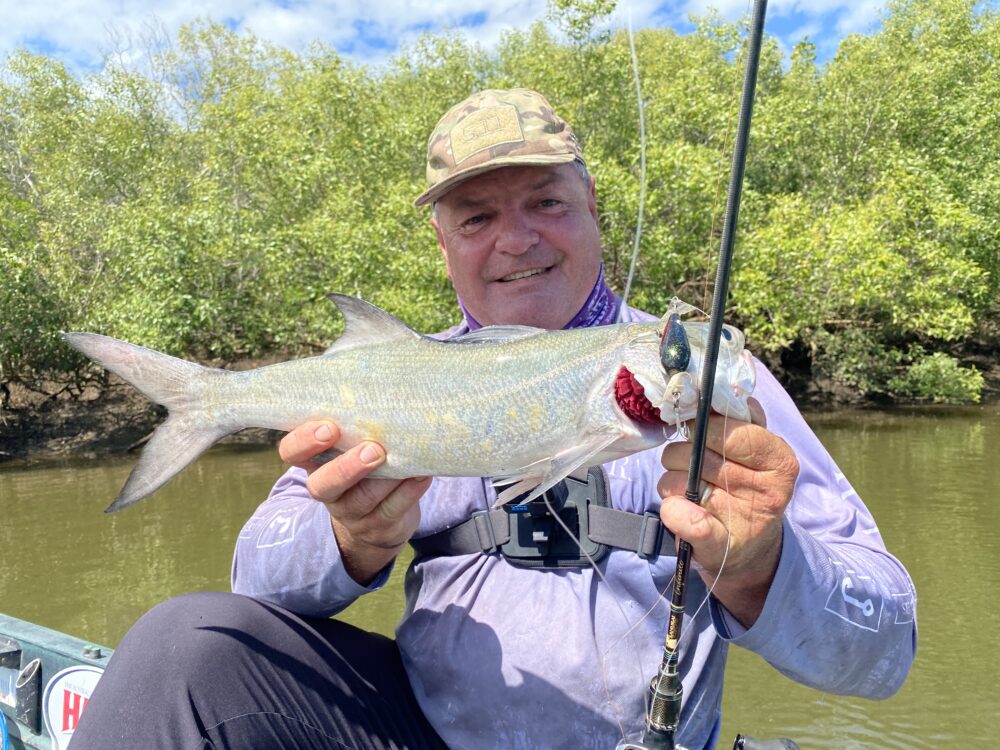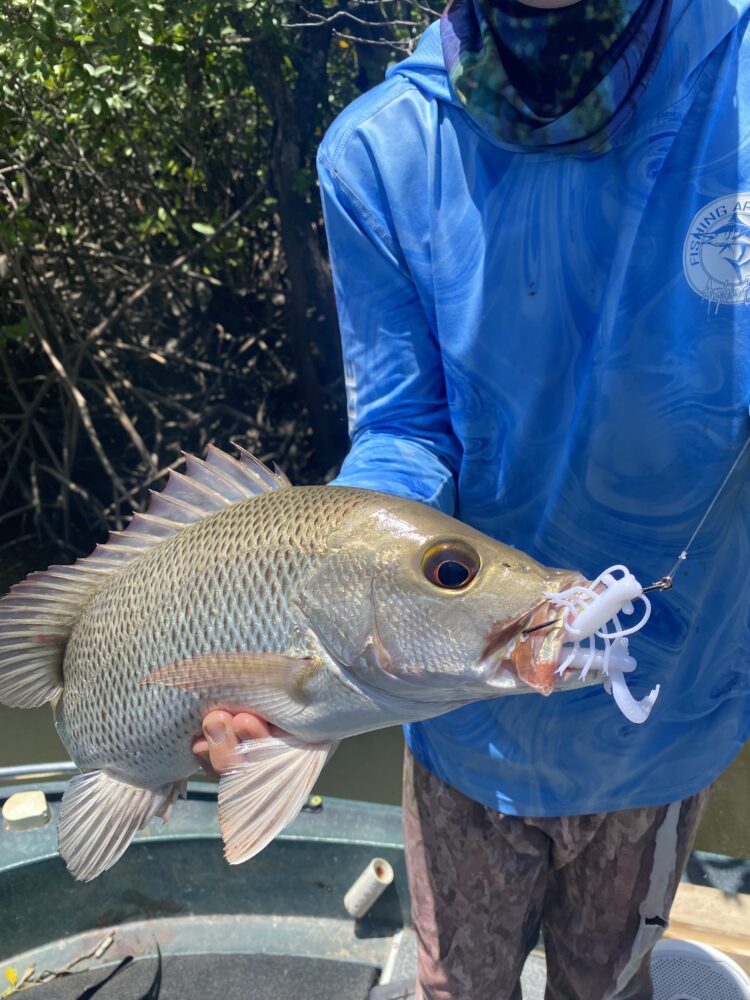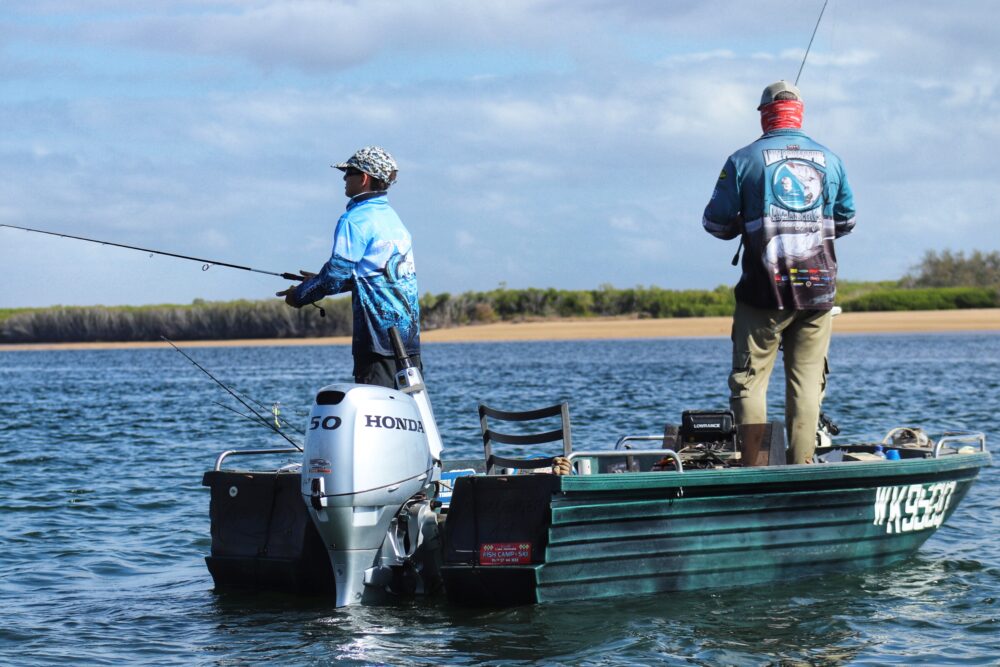Jacks, at Surface Value – By David Hodge
Sorry about being a while since my last article, as life sort of got in the road for a little while. Not that we haven’t found the time to fish, just the time to document some of the action. When it comes to lure casting targets, the angry mangrove jacks that are so prevalent in the north are our favourites to chase. If circumstances allow, our favourite way to target them is by far, on the surface. Many anglers aren’t too sure which surface presentation to use, or even when to use them, so in this piece I’ll try to explain which we use and why.

Smaller lures tend to get engulfed much more readily, and hookup ratio’s exceptional. This 60mm Rooster popper is a go to lure for us when things are a bit tough.
Aggression.
Pretty much as soon as we launch the boat we are looking for indications of feeding fish, and sometimes that means starting from the launch or where we are starting our walk. Generally speaking, we get the boat up on the plane and then cruise not too far from the shore line to try and observe any ripples coming from underneath the overhanging mangroves or trees. These are usually signs of feeding fish when those ripples are apparent, and those are often the days when the jacks will hit almost any surface presentation. This doesn’t happen that often so enjoy it when it does.
If there aren’t any signs or ripples that give you some sort of indication as to their aggression levels, it’s time to start looking for more specific areas to target your efforts. I’ll outline a typical day for us, which usually means an early start, and the tide timing is way less important for us, and that’s getting there as early as possible. When all the stars align and we happen to hit the water at a time when the tide is almost at the bottom, we tend to look for the slower tapered shallow banks that have receded away from standing mangroves out onto a sand or mud flat. Obviously, at low tide the water will slow considerably and even start to clear a little. Ledges, contour lines and drop offs are what we are looking for apart from the standard type structure that’s usually associated with mangrove jacks. These depth variations are lesser targeted for the jacks, but are some of our most productive areas to focus on, especially early morning. If there isn’t too much boat traffic around, the jacks will usually be in a pretty good mood, as long as you approach the target area stealthily and from a great distance on the electric. It’s not so much bait, or actively feeding fish that we are searching for, but if these are available it’s usually a great sign. Long distance casts are necessary to get the best from this type of scenario, and I have a specific outfit that has quickly become my favourite for the long distance stuff with the smaller lures, and that’s a Samurai Infinite 6 to 12 pound matched up to a Certate 2500, and spooled with 15 pound braid.

As mentioned just about everything wants to eat a Bills Bug. In this case a blue salmon, while searching for jacks under the mangroves.
This particular outfit is one that I usually use in open water where you don’t need massive stopping power such as in the snags where giving an inch of line can mean disaster. On the flats and more open contoured areas, if you have to let them run you can for whatever distance necessary. With the surface lures, the type and breaking strains of the leader material you choose will sometimes have a bearing on how well your lure actually works. If your surface lure is quite buoyant then you can usually get away with using a flouro carbon leader in say 20lb to 25lb breaking strains, but any heavier will sometimes sink the nose of the lure enough to compromise the amount of water dispersion or type of displacement the lure is designed to have. Some of the more subtle types such as stick baits or walk the dog types can have easily affected designs, so this is where you may need to decide whether the normal old mono line needs to be considered. Mono doesn’t sink in the same way that flouro carbon does which may need to be considered if you have any issues with dampening of the lures action. The main benefit though is that the lighter lines make casting the smaller lures any great distance a breeze.
Not to be controversial, but when you hear of people using 4 pound braid, myself included, it’s not really 4 pound, as many break at close to the 15 pound mark anyway. It’s more the lines diameter which will give you a true indication of a lines breaking strains and abrasion resistance, but let’s leave that alone, as it’s actually quite a controversial topic.
Poppers.
So called for the noise they make with a swift and short jab of the rod tip, poppers are probably the longest lived surface design that Aussie anglers can relate to. Important with any surface lure is cast-ability, giving the angler long distances effortlessly. If you were to pick a happy medium size for the jacks it would be the 60mm size in my opinion, and the 80mm is a big fish lure which accounts coincidently for many of our barra captures. We sometimes manage to straighten the hooks on the 60mm but this is usually after removing them from a few captured fish, as I find that I do more damage to a treble by removing it, than what the fish actually does during the strike and fight. Retrieves are as straight forward as it gets, with a short sharp jab of the rod tip, then allowed to sit for a couple of seconds. Again sitting bum down at rest assists with a great hookup ratio. For some reason, every time my young fella ties one of these things on he seems to catch good sized jacks, and is often his and my go to lure when things are a bit quiet. Working in all enrolments, they are extremely effective in wind chop and faster flowing water as that blooping noise really draws fish in from a distance.

When a Jack decides to smash a blooping surface popper like this one taken on a 60mm Halco Rooster popper, you know all about it. It’s real ‘change your undies’ type stuff.
Bassday Sugarpen.
When water visibility is reasonable, say .5m, the Sugarpen 90mm is a terrific lure for covering water quickly and being able to achieve massive casting distances for a small lure. Small spots of water that are emitted from the nose during the twitching action are a big turn on for wary fish. Hooks are Gamakatsu so the sharpness will never be a question. To be honest, a hook points sharpness is critical for surface lures hookup ratio as they’re often a swiping type of strike, and regularly hookup outside the mouth. Simple to use, the action is a straightforward and constant twitch, wind, twitch, wind, retrieve only pausing if there is a swirl underneath it or interest from a fish. With a bum down type swim action, the hookups are generally pretty consistent.
Fizzers
It’s no secret that I’m a massive fan of the Fizzers, but generally there’s only one that I’d recommend over all others, and that’s the Bills Bug range made by Bill Clarke from down south. Their sound is unique, and durability very good. Sounding more like a bait fishes panicked, high frequency tail action on the surface, they’re a cracking lure for many species, but for us, it’s the jacks and barra that we use them for. Retrieves can be varied from short jabs, to long sweeps of the rod with pauses in between, to straight, slow rolling retrieves which will all get eaten. Sadly they’re no longer available in store but they can be ordered direct from Bill himself and his adverts are on Facebook as well as having a web site. Bill is one of the most highly respected anglers and lure manufacturers I’ve ever been privileged enough to meet, and having stuck with his traditional colours, make the range simple and effective to choose from. For the jacks we use the mouse and the 70mm Fizzers and as with the previous lures, can highly recommend them. Just have a look on YouTube at the amount of anglers who use them, ourselves included and they’re very popular for a reason. They work in fast water, wind chop, glassed out conditions and everything in between.

Rigged weedless, the Atomic Prongs are a very effective tool when used in a constant speed retrieve to search for active fish at a fast pace.
Frogs and soft plastic surface.
No one could deny the surface lure phenomenon and the excitement an angler gets from it, and with countless anglers using them now days it goes to show the need to be versatile. The thing is, getting the bite is one thing, but making that hook stick can be a frustration. Generally, rigged weed-less and thrown into thick cover like mangroves, weed, grassy ledges etc, the weed-less presentations are renowned for being able to get bites, but can be frustrating when it comes to converting bites into a bent rod. It’s important though to realise that frogs aren’t the only soft plastic that can be rigged and fished on the surface. With quite a lot of body material in some of the frog imitations to achieve the correct profile, buoyancy is another factor that requires the amount of material to be used so as to float the hook at rest. Depending on the material used to manufacture a soft plastic, it will either sink or float at rest, and obviously floating would be the best option for a surface presentation. We will quite often rig the 5 and 7 inch Halco Paddle Prawns on a weed-less hook unweighted and this is a very easy lure to skip, retrieve and use in general. They float at rest when rigged on a 3/0 or 4/0 Gamakatsu unweighted EWG hook and I do find the hookup ratio quite good comparatively speaking. If we are covering water quickly, then we will often rig the Atomic Prong similarly with the difference being that it sinks when at rest, and all this means is that the lure must be kept moving on the surface in order to achieve that surface disturbance. Colour is a personal thing obviously, but white is accepted as being a good all rounder.
A few other aspects of surface fishing that will influence your hookup ratio are the type of rod you use, with a softer tip delivering a greater hookup per strike ratio. The angle the angler holds the rod on while retrieving the lure also effects the success of surface lures connectivity. Holding the rod to the side or upwards allows a lot of ‘suck in’ room for the lure to travel backwards into the fishes mouth as they inhale, and a rod tip pointed at the lure will often see the hook miss its mark.
Sometimes you can catch fish all day long on the mentioned lures, while at other times it may just be brief half hour to hour long windows that present themselves. Either way, if you haven’t got a selection of surface lures in your kit, you’re missing a big piece of the achievable action we all seek.
Good luck. Hodgie.

I honestly believe that the silence the Poly Craft hull delivers on water, particularly in wind chop helps us stalk fish much more effectively.





